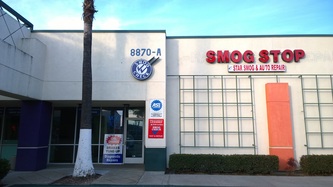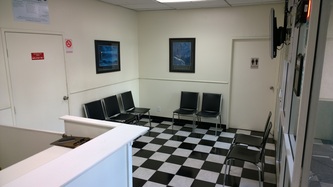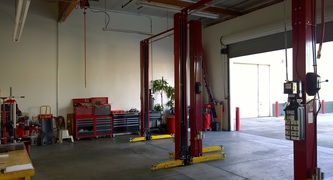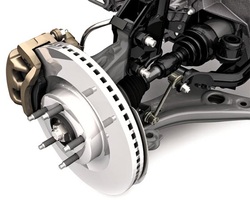
Brake Service
Are your brakes squeaking,grinding, pulling to one side, pulsating, making noise?
Pedal mushy, hard to press or low? ABS light on? Car not stopping right?
Let us assist you with whatever your brake service needs may be.
Are your brakes squeaking,grinding, pulling to one side, pulsating, making noise?
Pedal mushy, hard to press or low? ABS light on? Car not stopping right?
Let us assist you with whatever your brake service needs may be.
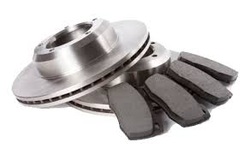
Our brake system evaluation examines your entire braking system to accurately determine exactly what problem you may have and what it will take to get you back on the road safely.
Stop in today for a FREE estimate!
Remember: Regular brake inspections should be part of your vehicle’s ongoing maintenance, helping to ensure its safety and reliability.
Stop in today for a FREE estimate!
Remember: Regular brake inspections should be part of your vehicle’s ongoing maintenance, helping to ensure its safety and reliability.
8870 Archibald Ave, STE # A,
Rancho Cucamonga CA 91730
909 484 7664, 909 581 1980. Open Mon-Fri 8:30 Am - 5:00 PM Saturday 8:30 AM - 3:00 PM
Rancho Cucamonga CA 91730
909 484 7664, 909 581 1980. Open Mon-Fri 8:30 Am - 5:00 PM Saturday 8:30 AM - 3:00 PM
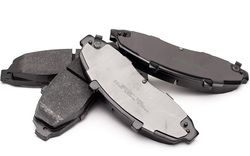
Which Brake Pads do I need ?
A common question many drivers have when it comes time for new brakes is, “What’s the difference between Ceramic vs. Metallic or Organic brake pads?” While they all serve the same function, the short answer is “a lot.” For the longer answer, read on…
Brake pads: What to look for
What to do when having servicing done
While the federal government sets performance standards for brake systems in new vehicles, there are no government regulations covering replacement brake pads.
The brake system is one of the most critical elements of vehicle safety—it's important to understand the choices consumers face when taking their vehicles to a brake shop. The cheapest brake job may compromise safety, and the most expensive parts may not make your vehicle any safer than the standard part.
Servicing brakes 25 years ago required few decisions other than choosing a mechanic. Disc and drum brakes used only two types of friction materials—semimetallic and asbestos. The mechanic simply replaced the old pad or shoe with the same type. Aftermarket suppliers rarely offered different performance grades or price points for either type of pad.
Today, however, asbestos has been all but eliminated, because it can't meet contemporary cars' higher performance standards as well as concern over health hazards from asbestos dust. Automaker suppliers have developed additional friction compounds, and the aftermarket now offers a dizzying array of replacement brake products under dozens of brand names.
The different friction materials in use today often have design compromises. While one may offer superior heat transfer—and therefore better braking performance—it may also be noisier and more prone to depositing unsightly brake dust on the wheel rims. Another friction compound may have a soft feel, and work quietly, but wear out much more quickly.
What to do when having servicing done
While the federal government sets performance standards for brake systems in new vehicles, there are no government regulations covering replacement brake pads.
The brake system is one of the most critical elements of vehicle safety—it's important to understand the choices consumers face when taking their vehicles to a brake shop. The cheapest brake job may compromise safety, and the most expensive parts may not make your vehicle any safer than the standard part.
Servicing brakes 25 years ago required few decisions other than choosing a mechanic. Disc and drum brakes used only two types of friction materials—semimetallic and asbestos. The mechanic simply replaced the old pad or shoe with the same type. Aftermarket suppliers rarely offered different performance grades or price points for either type of pad.
Today, however, asbestos has been all but eliminated, because it can't meet contemporary cars' higher performance standards as well as concern over health hazards from asbestos dust. Automaker suppliers have developed additional friction compounds, and the aftermarket now offers a dizzying array of replacement brake products under dozens of brand names.
The different friction materials in use today often have design compromises. While one may offer superior heat transfer—and therefore better braking performance—it may also be noisier and more prone to depositing unsightly brake dust on the wheel rims. Another friction compound may have a soft feel, and work quietly, but wear out much more quickly.
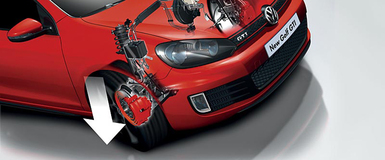
Do you need new brake pads?
If you feel your vehicle behaving differently or you feel uncomfortable while barking have it checked out.
Usually, the first sign of excessive brake-pad wear is a high-pitched squealing.This sound comes from a soft-metal wear indicator that rubs against the brake rotor to alert the driver that a change is needed. Other symptoms can include the vehicle pulling to one side under braking, the brakes grabbing or vibrating, and the brake pedal feeling softer to depress. A grinding sound means that replacement is overdue and the worn brake pads may be damaging the brake rotors. Always check the owner's manual for any brake-related recommendations, including pad replacement intervals.
If you feel your vehicle behaving differently or you feel uncomfortable while barking have it checked out.
Usually, the first sign of excessive brake-pad wear is a high-pitched squealing.This sound comes from a soft-metal wear indicator that rubs against the brake rotor to alert the driver that a change is needed. Other symptoms can include the vehicle pulling to one side under braking, the brakes grabbing or vibrating, and the brake pedal feeling softer to depress. A grinding sound means that replacement is overdue and the worn brake pads may be damaging the brake rotors. Always check the owner's manual for any brake-related recommendations, including pad replacement intervals.
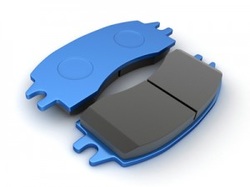
Types of brake pads
There are four general types of brake pads for cars and trucks:
Semimetallic: This formula, containing about 30 to 65 percent metal, typically includes chopped steel wool or wire, iron powder, copper or graphite mixed with inorganic fillers, and friction modifiers that bond all the ingredients together. These pads are more durable and have excellent heat transfer, but also wear down rotors faster, can be noisy, and may not perform optimally at low temperatures.
Nonasbestos organic: Sometimes listed as organic or NAO, this type of pad is made from fibers, such as glass, rubber, carbon, and Kevlar, with filler materials and high-temperature resins. These pads are softer and create less noise, but they wear faster and create more dust.
Low-metallic NAO: These are made from an organic formula mixed with small amounts (10 to 30 percent) of copper or steel to help with heat transfer and provide better braking. With the added metal, there is more brake dust and they may be slightly noisier.
Ceramic: These are composed of ceramic fibers, nonferrous filler materials, bonding agents, and possibly small amounts of metal. Lighter in color and more expensive than other brake pads, ceramic pads are cleaner and quieter, and offer excellent braking characteristics without wearing down the rotors.
There are four general types of brake pads for cars and trucks:
Semimetallic: This formula, containing about 30 to 65 percent metal, typically includes chopped steel wool or wire, iron powder, copper or graphite mixed with inorganic fillers, and friction modifiers that bond all the ingredients together. These pads are more durable and have excellent heat transfer, but also wear down rotors faster, can be noisy, and may not perform optimally at low temperatures.
Nonasbestos organic: Sometimes listed as organic or NAO, this type of pad is made from fibers, such as glass, rubber, carbon, and Kevlar, with filler materials and high-temperature resins. These pads are softer and create less noise, but they wear faster and create more dust.
Low-metallic NAO: These are made from an organic formula mixed with small amounts (10 to 30 percent) of copper or steel to help with heat transfer and provide better braking. With the added metal, there is more brake dust and they may be slightly noisier.
Ceramic: These are composed of ceramic fibers, nonferrous filler materials, bonding agents, and possibly small amounts of metal. Lighter in color and more expensive than other brake pads, ceramic pads are cleaner and quieter, and offer excellent braking characteristics without wearing down the rotors.
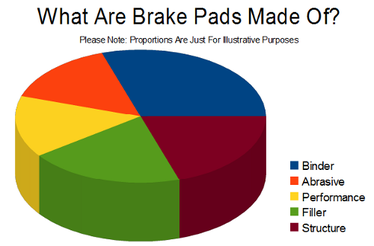
How to choose
While a large selection brings down prices, consumers can be confused by slick packaging, clever brand names, and pushy mechanics. Some consumers are even unaware that asbestos replacement pads are still available. Unlike foods that have ingredient labels, brake pads have no content labeling. In fact, the formulas are highly guarded secrets and can vary even within a manufacturer's own line, depending on what type of vehicle the pads are intended for. Full-size pickups, for instance, may need more metal—for additional stopping power and reduced brake fade—than compact cars, which can use organic materials just as effectively.
Most manufacturers offer a range of pads for each application, but consumers shouldn't be fooled into believing it's always a good-better-best choice. Nor will a family be safer with the most expensive replacement pad. The standard pad, if certified (see below), should meet the demands of normal driving. Upgraded pads for normal driving will likely be noisier, produce more dust, and possibly respond with a harder pedal feel. But if you tow, carry heavy loads or numerous passengers often, live in hilly or mountainous areas, or have a daily commute down a steep grade, you should consider an upgraded or severe-duty pad.
What's the price difference? We looked at the line of pads from one major company for a late-model Chevrolet Tahoe. The standard pad retailed for $68 per set (enough to cover two wheels) followed by an upgraded version at $87 and a severe-duty set at $98. Ceramic pads are more expensive ($120 for the Tahoe), but the advantages may be worth the extra money to many, especially those with custom wheels. Ceramic pads will help solve noise and dust problems as well as offer excellent stopping performance and comfortable pedal feel.
While a large selection brings down prices, consumers can be confused by slick packaging, clever brand names, and pushy mechanics. Some consumers are even unaware that asbestos replacement pads are still available. Unlike foods that have ingredient labels, brake pads have no content labeling. In fact, the formulas are highly guarded secrets and can vary even within a manufacturer's own line, depending on what type of vehicle the pads are intended for. Full-size pickups, for instance, may need more metal—for additional stopping power and reduced brake fade—than compact cars, which can use organic materials just as effectively.
Most manufacturers offer a range of pads for each application, but consumers shouldn't be fooled into believing it's always a good-better-best choice. Nor will a family be safer with the most expensive replacement pad. The standard pad, if certified (see below), should meet the demands of normal driving. Upgraded pads for normal driving will likely be noisier, produce more dust, and possibly respond with a harder pedal feel. But if you tow, carry heavy loads or numerous passengers often, live in hilly or mountainous areas, or have a daily commute down a steep grade, you should consider an upgraded or severe-duty pad.
What's the price difference? We looked at the line of pads from one major company for a late-model Chevrolet Tahoe. The standard pad retailed for $68 per set (enough to cover two wheels) followed by an upgraded version at $87 and a severe-duty set at $98. Ceramic pads are more expensive ($120 for the Tahoe), but the advantages may be worth the extra money to many, especially those with custom wheels. Ceramic pads will help solve noise and dust problems as well as offer excellent stopping performance and comfortable pedal feel.
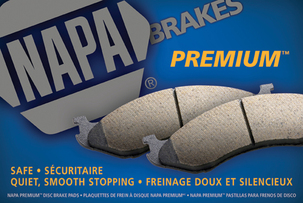
Look for a certified label
New vehicles must meet federal performance standards—a minimum stopping distance in a variety of situations under a specified pedal effort. Many consumers assume all aftermarket replacement pads will perform just as well or better than factory parts, but that's not necessarily the case.
In an effort to improve the customer's comfort level—and also to avoid future government regulations—brake manufacturers can test and verify their products under two voluntary certification standards. Both are designed to ensure that replacement brakes are as effective as original equipment, and consumers should make sure that any pads being installed on their vehicle are certified.
The first is an independent proprietary program developed by Greening Testing Laboratories in Detroit called D3EA—which stands for Dual Dynamometer Differential Effectiveness Analysis. This procedure tests front and rear friction materials together on dual dynamometers, then simulates vehicle weight and speed through a computer program to measure braking effectiveness and balance for different applications. D3EA was introduced in 1996, and among the first aftermarket companies to achieve D3EA certification were ACDelco, NAPA, Raybestos, and Satisfied.
The Brake Manufacturers Council (BMC) has a second certification standard called BEEP, or Brake Effectiveness Evaluation Procedure. BEEP testing is conducted on a single dynamometer, and the numbers are washed through a computer program to compare brake performance with federal standards for new vehicles. The BEEP approval seals appear on packaging as manufacturers submit products for certification.
The D3EA tests are proprietary and more expensive, but they're also completely independent and tougher to pass. Brake manufacturers have contended that most consumers change only the front or rear brakes at one time, so a concurrent dual test is unnecessary. But, according to officials from Greening, NHTSA tests in the 1980s concluded there was a significant reduction in braking performance when there was a differential between front and rear replacement pads as compared with original factory parts. That report provided some of the motivation for the brake industry to begin seeking a certification standard before the federal government issued regulations for replacement pads. The obvious concern over BEEP testing is that the manufacturers themselves oversaw the development of the certification standards. While the program received input from the Society of Automotive Engineers and actual certification is currently conducted at an independent laboratory, BMC members can conduct similar tests on their own single dynamometers and compute the numbers.
Consumers must remember that not all of an aftermarket manufacturer's lineup gets certified, only pads designed for a specific vehicle that passed the designated test. Also, since the D3EA tests are expensive, manufacturers may test just the standard line for a particular vehicle. One can assume then that any upgraded line from that same manufacturer will meet the test standards. That's why heavy duty or the new ceramic pads may not carry the seal. The best advice is to look for manufacturers that aggressively test their standard line, then move up in grade if you need more performance or seek other advantages such as minimal wheel dust.
New vehicles must meet federal performance standards—a minimum stopping distance in a variety of situations under a specified pedal effort. Many consumers assume all aftermarket replacement pads will perform just as well or better than factory parts, but that's not necessarily the case.
In an effort to improve the customer's comfort level—and also to avoid future government regulations—brake manufacturers can test and verify their products under two voluntary certification standards. Both are designed to ensure that replacement brakes are as effective as original equipment, and consumers should make sure that any pads being installed on their vehicle are certified.
The first is an independent proprietary program developed by Greening Testing Laboratories in Detroit called D3EA—which stands for Dual Dynamometer Differential Effectiveness Analysis. This procedure tests front and rear friction materials together on dual dynamometers, then simulates vehicle weight and speed through a computer program to measure braking effectiveness and balance for different applications. D3EA was introduced in 1996, and among the first aftermarket companies to achieve D3EA certification were ACDelco, NAPA, Raybestos, and Satisfied.
The Brake Manufacturers Council (BMC) has a second certification standard called BEEP, or Brake Effectiveness Evaluation Procedure. BEEP testing is conducted on a single dynamometer, and the numbers are washed through a computer program to compare brake performance with federal standards for new vehicles. The BEEP approval seals appear on packaging as manufacturers submit products for certification.
The D3EA tests are proprietary and more expensive, but they're also completely independent and tougher to pass. Brake manufacturers have contended that most consumers change only the front or rear brakes at one time, so a concurrent dual test is unnecessary. But, according to officials from Greening, NHTSA tests in the 1980s concluded there was a significant reduction in braking performance when there was a differential between front and rear replacement pads as compared with original factory parts. That report provided some of the motivation for the brake industry to begin seeking a certification standard before the federal government issued regulations for replacement pads. The obvious concern over BEEP testing is that the manufacturers themselves oversaw the development of the certification standards. While the program received input from the Society of Automotive Engineers and actual certification is currently conducted at an independent laboratory, BMC members can conduct similar tests on their own single dynamometers and compute the numbers.
Consumers must remember that not all of an aftermarket manufacturer's lineup gets certified, only pads designed for a specific vehicle that passed the designated test. Also, since the D3EA tests are expensive, manufacturers may test just the standard line for a particular vehicle. One can assume then that any upgraded line from that same manufacturer will meet the test standards. That's why heavy duty or the new ceramic pads may not carry the seal. The best advice is to look for manufacturers that aggressively test their standard line, then move up in grade if you need more performance or seek other advantages such as minimal wheel dust.
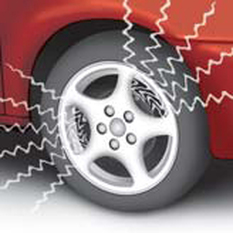
Why Do My Brakes Squeal?
Normal Pad Noises
Many brake pad compositions will make a swishing or grinding noise for the first few stops in the morning until the pads warm up and drive off any moisture they've accumulated overnight. Ever notice a hissing or grinding noise on some rainy or dewy mornings? It's the pads sweeping a thin film of rust that's formed on the iron discs, and it's perfectly normal.
In the past, brake pad friction material relied heavily on asbestos. Unfortunately, asbestos tended to give asbestos workers and brake mechanics lung cancer, so the industry has almost completely changed over to less dangerous alternatives.That leads to the increased use of metallics and ceramics in the brake pad friction material. And this stuff can make the brakes hiss or even grind a little as you slow down. It's a small price to pay for increased performance.
So all pad noise is fine, right? Not at all No, there's one brake noise you need to pay attention to right away. Many brake pads have a small finger of spring steel that will scrape on the disc as the pad reaches its wear limit. This tells you that it's time to change pads and you hear a squeal or scraping sound.
It can be a little confusing so just get them checked.
Normal Pad Noises
Many brake pad compositions will make a swishing or grinding noise for the first few stops in the morning until the pads warm up and drive off any moisture they've accumulated overnight. Ever notice a hissing or grinding noise on some rainy or dewy mornings? It's the pads sweeping a thin film of rust that's formed on the iron discs, and it's perfectly normal.
In the past, brake pad friction material relied heavily on asbestos. Unfortunately, asbestos tended to give asbestos workers and brake mechanics lung cancer, so the industry has almost completely changed over to less dangerous alternatives.That leads to the increased use of metallics and ceramics in the brake pad friction material. And this stuff can make the brakes hiss or even grind a little as you slow down. It's a small price to pay for increased performance.
So all pad noise is fine, right? Not at all No, there's one brake noise you need to pay attention to right away. Many brake pads have a small finger of spring steel that will scrape on the disc as the pad reaches its wear limit. This tells you that it's time to change pads and you hear a squeal or scraping sound.
It can be a little confusing so just get them checked.
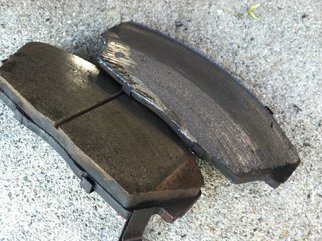
Worn Pads
A brake pad is comprised of steel backing with friction material attached to it. Application of the brakes produces hydraulic pressure that causes the brake pads (via brake calipers) to clamp down on the rotors (discs) creating friction. It is the friction of the pads against the rotors that slows and stops the vehicle. When the friction material on the pads wears down, it is time to change the pads. Some pads are equipped with a wear indicator, which is a small spring steel clip. When a pad is worn, this clip makes contact with the rotor and generates a high-pitched squeal, telling you that it is time to service the brakes. If the pad does not have a wear indicator, then when the pad has worn down to the steel backing it will grind into the rotor and need to be replaced. In this scenario, the rotor may have to be replaced as well, depending on how badly it was affected.
A brake pad is comprised of steel backing with friction material attached to it. Application of the brakes produces hydraulic pressure that causes the brake pads (via brake calipers) to clamp down on the rotors (discs) creating friction. It is the friction of the pads against the rotors that slows and stops the vehicle. When the friction material on the pads wears down, it is time to change the pads. Some pads are equipped with a wear indicator, which is a small spring steel clip. When a pad is worn, this clip makes contact with the rotor and generates a high-pitched squeal, telling you that it is time to service the brakes. If the pad does not have a wear indicator, then when the pad has worn down to the steel backing it will grind into the rotor and need to be replaced. In this scenario, the rotor may have to be replaced as well, depending on how badly it was affected.
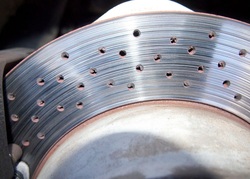
Glazed Pads and Rotors
Brake squeal can also occur when brake calipers stick and the brake stays partially applied. When this happens the pad is in constant contact with the rotor, producing excessive friction and thus heat. Overheated pads harden and crystallize. This glazing occurs on the rotors as well. The squealing sound is a result of these super hardened surfaces coming in contact with one another. Remember, it is the friction created by the brake pad against the rotor that stops a vehicle. When crystallization of pad and rotor occurs, there is much less friction. This results in diminished braking power and squealing brakes. At this point the pads must be replaced and the rotors resurfaced or replaced.
Brake squeal can also occur when brake calipers stick and the brake stays partially applied. When this happens the pad is in constant contact with the rotor, producing excessive friction and thus heat. Overheated pads harden and crystallize. This glazing occurs on the rotors as well. The squealing sound is a result of these super hardened surfaces coming in contact with one another. Remember, it is the friction created by the brake pad against the rotor that stops a vehicle. When crystallization of pad and rotor occurs, there is much less friction. This results in diminished braking power and squealing brakes. At this point the pads must be replaced and the rotors resurfaced or replaced.
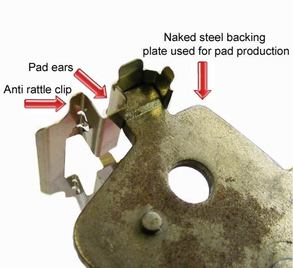
Broken Anti Rattle Clips
The brake pad is loosely held in place on the caliper by pad stays. An additional part called an anti rattle clip is used to secure the pad so that it will not vibrate or rattle when the brake is applied. If anti rattle clips are worn or broken, pad vibration will cause squealing. In this case, the clips must be replaced.
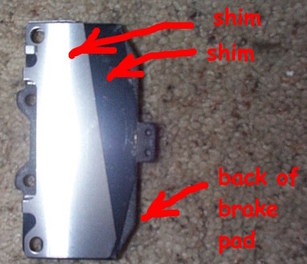
Lack of Pad Insulation or Insulation Shims
When a car comes from the factory, insulation shims are placed against the steel backing of the pad to insulate it from the brake caliper. This is necessary to prevent brake squeal. These shims eventually wear out or they are discarded when a brake job is performed. When the pads are replaced, either the shims must be replaced or silicone insulation gel must be applied to prevent squeal. If you had your front brakes replaced recently and they're squealing, take it back to the shop and make sure the shims were installed or gel was used.
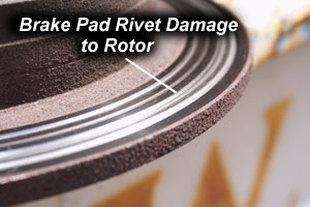
Incorrect Rotor Surface Cut or No Surface Cut at All
When a brake job is performed, the rotors must be resurfaced to remove any glazing and return the surface to "true." First the rotor is machined to remove grooves and/or imperfection on the rotor surface. Once the rotor face is "true," a slow, non-directional finish is applied to the rotor face to ensure proper break-in of the pads. This process also insures that the pads don't ride up on the face of the rotor when braking. Riding up of the pads can cause a clicking noise, the breaking of anti rattle clips, or caliper pin wear. If the rotor is found to be too thin according to state inspection rules, it is discarded and replaced. It is important to note that if your pads were replaced without resurfacing the rotors, then squealing and pedal pulsation will probably occur.
When a brake job is performed, the rotors must be resurfaced to remove any glazing and return the surface to "true." First the rotor is machined to remove grooves and/or imperfection on the rotor surface. Once the rotor face is "true," a slow, non-directional finish is applied to the rotor face to ensure proper break-in of the pads. This process also insures that the pads don't ride up on the face of the rotor when braking. Riding up of the pads can cause a clicking noise, the breaking of anti rattle clips, or caliper pin wear. If the rotor is found to be too thin according to state inspection rules, it is discarded and replaced. It is important to note that if your pads were replaced without resurfacing the rotors, then squealing and pedal pulsation will probably occur.
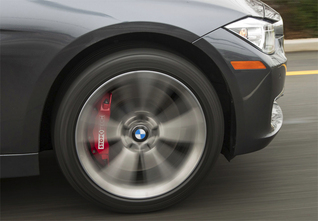
Brake Pad & Rotor Bed-In Procedures
All brake pads must be bedded-in with the rotor they will be used against to maximize brake performance.Bedding allows your brakes to reach their full potential. Until they are bedded, brakes simply do not work as well as they can. The bedding-in process involves a gradual build up of heat in the rotors and pad compound. This process will lay down a thin layer of transfer film on to the rotor surface. Following the bed-in procedures provided by the manufacturer will assure a smooth, even layer of transfer film on the rotor and will minimize brake judder.
Bedding-in new pads and rotors should be done carefully and slowly. Rapid heat build up in the brake system can lead to warped rotors and or glazed brake pads. Most brake pad compounds will take up to 300-400 miles to fully develop an even transfer film on the rotors.
Go easy on the brakes during the bed in period how ever in an emergency or when you need to stop fast or brake aggressively please do so.
*All the information above has been gathered form different web sources.
Hope this information is helpful to you
Call us if you have any questions.
909 484 7664
909 581 1980
All brake pads must be bedded-in with the rotor they will be used against to maximize brake performance.Bedding allows your brakes to reach their full potential. Until they are bedded, brakes simply do not work as well as they can. The bedding-in process involves a gradual build up of heat in the rotors and pad compound. This process will lay down a thin layer of transfer film on to the rotor surface. Following the bed-in procedures provided by the manufacturer will assure a smooth, even layer of transfer film on the rotor and will minimize brake judder.
Bedding-in new pads and rotors should be done carefully and slowly. Rapid heat build up in the brake system can lead to warped rotors and or glazed brake pads. Most brake pad compounds will take up to 300-400 miles to fully develop an even transfer film on the rotors.
Go easy on the brakes during the bed in period how ever in an emergency or when you need to stop fast or brake aggressively please do so.
*All the information above has been gathered form different web sources.
Hope this information is helpful to you
Call us if you have any questions.
909 484 7664
909 581 1980
Smog Stop - Star Smog & Repair Station.
8870 Archibald Ave, STE # A,
Rancho Cucamonga CA 91730 909 484 7664 909 581 1980 smogstop.co
8870 Archibald Ave, STE # A,
Rancho Cucamonga CA 91730 909 484 7664 909 581 1980 smogstop.co


